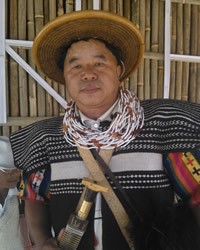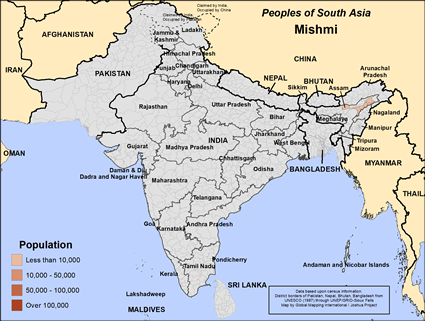Mishmi in India

Photo Source:
Vaivhav Todi
|

Map Source:
People Group data: Omid. Map geography: UNESCO / GMI. Map Design: Joshua Project
|
| People Name: | Mishmi |
| Country: | India |
| 10/40 Window: | Yes |
| Population: | 24,000 |
| World Population: | 24,000 |
| Primary Language: | Digaro-Mishmi |
| Primary Religion: | Unknown |
| Christian Adherents: | 4.98 % |
| Evangelicals: | 0.00 % |
| Scripture: | Portions |
| Ministry Resources: | Yes |
| Jesus Film: | Yes |
| Audio Recordings: | Yes |
| People Cluster: | South Asia Tribal - other |
| Affinity Bloc: | South Asian Peoples |
| Progress Level: |
|
Introduction / History
Mishmi is a tribe in Arunachal Pradesh which lives in the weakest economic conditions. They have their own language, Digaro-Mishmi.
What Are Their Lives Like?
The main economic resources of the Mishmis are land and forests. They are primarily farmers. One of the traditional occupations of the Mishmis is weaving, which also involves them in trading in order to sell what they make. Mishmis also produce shawls, blouses, jackets, bamboo baskets, skirts, coats, bags and bead necklaces.
Mishmis are non-vegetarians. Men and children consume pork, beef and all other kinds of meat available. However, the women eat only small birds and fish.
Their houses are made of bamboo and the roof is thatched with long grass. The peculiarity of these houses is that they are made on pillars and the basement of the house is used for keeping pigs and hens.
What Are Their Beliefs?
Mishmis are the followers of the animistic Donyi-polo faith, known as Phong kelum, with some Buddhist influence, notably in their rites. Shamanism is also prominent in their beliefs, and the position of shaman is hereditary. The most important characteristics is a complex system of beliefs in the spiritual qualities of nature and the concept of one supreme being. Donyi-polo the sun and the moon are regarded as the symbol of eternal truth.
They sacrifice animals like mithun and pigs for a number of rituals and pujas during festivals. They have pre and post-delivery rituals. They believe in some malevolent and benevolent spirits.
What Are Their Needs?
The Mishmi people need to be introduced to the only savior, the one who can give them life to the full. As it stands, they are at the mercy of a malevolent spirit world.
Prayer Points
Pray for them to understand and respond to Christ.
Pray God will have mercy on the Mishmi people, doing whatever it takes to place them in a position to receive him.
Ask God to open the hearts of the Mishmi to the gospel.
Pray for an unstoppable movement to Christ.